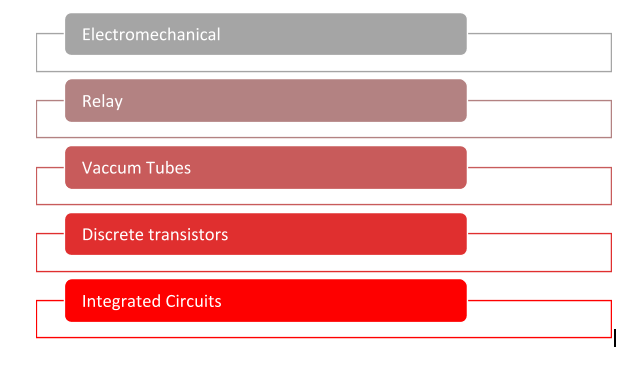Can you imagine a world without internet or smartphones?
It’s hard to even fathom such a concept. How will we go on with our daily lives, now that internet and smartphones have become such an integral part of our lives?
How will we google away our problems and queries? What if we had to write an essay on Britain’s history and won’t be able to google “UK assignment help” or hire services online by searching “write my dissertation”?
But what if I tell you that there were no smartphones just 10 years back. Seems like a lifetime ago, doesn’t it?
Fun fact: there were no computers almost 60 years ago and personal computers became common around just 25 years ago.
It doesn’t seem like a lot of time that humans has gone from inventing the computers to now developing robots and working on artificial intelligence.
So how do we quantify the speed of growth?
Mr. Gordon Moore, the founder if Intel corporations and inventor of transistors gave the famous “Moore’s Law” in 1965. It is an empirical law that predicted the rate of human development with respect to the size of transistors on a chip.
Don’t worry, I’ll explain the law better.
The law states that the number of transistors on a chip doubles every two years, and that in turn directly effects that rate of human development.
So in layman’s term, the reduction is size of transistor chip or what is commonly called integrated circuits, is directly proportional to human development.
See, it wasn’t that hard.
Can we see the effects of Moore’s law?
Moore’s law has been valid for almost 5 decades now and we can see the practical implications of this law in our real life. Almost 60 years back computers were as big as a room, and now we have portable sized ones that we keep in our pockets or wear on our wrists. Or the fact that we are making robots that we have incorporated with artificial intelligence to learn and act like humans and the famous self-driving cars.
But now, Moore’s law is becoming obsolete, mainly due to the limitations of physics. As humans have been successful in reducing the size of transistors, we have reached a point where transistors are in the range of nanometers and further reduction of the size is not possible; as we cannot reduce the size lower than the atomic size of silicon particles that are used to make the substrate of chips.
Will the Humans stop developing?
It is debatable that whether humans will stop developing when Moore’s law reaches it’s exhaustion.
One of the most prominent counter argument is “The Law of Accelerating Returns”.
Wait, another law?
Yes, but it’s a bit more intuitive one and easy to understand.
“The Law of Accelerating Returns” state that, the human growth process increases exponentially over time. In comparison to Moore’s law that stated that speed of growth was linear.
Where Moore’s law talks about the present scenario of human growth, Law of Accelerating Returns talks about the past, the present and even the future of human growth.
The bigger picture
If we look at the bigger picture, it took humans thousands of years to develop primitive things like fire, sharp edged tools and wheels. Then hundreds more to reach industrial revolution. Then decades more for technological revolution. Lastly the human growth in the last few years have outpaced all previous milestones in human development.
But what about Moore’s Law’s limitations?
The Law of Accelerating Returns argues that a specific paradigm (i.e. in this case it is reducing size of transistors to make computers more powerful) will provide exponential growth in human development till the time that particular paradigm gets exhausted.
When exhaustion or saturation point is reached a natural shift of paradigm occurs, which then continues the exponential growth.
In short whenever one paradigm saturates, another one replaces it. But the growth never stops.
This law classifies the Moore’s law’s paradigm of integrated circuits at 5th paradigm of computing.
The 5 paradigms of Computing

How have humans adapted to this pace?
One of the major factors in this growth is the ability of humans to adapt to its pace. If the humans wouldn’t have coped up with the progress, then the whole concept of growth would’ve been obsolete. The mankind’s desire for development itself has enabled them to progress at such a pace.
This tells a lot about our consumerist society, that like living a fast paced life and are not afraid to incorporate new technology that can have a quick and lasting impact on their lives.
This human behavior has also perpetuated a competitions between developers and researchers, and is the encouraging factor for them to double down on their research and development projects. Which I the main cause of the development growth.
The Butterfly Effect
The gist of butterfly effect is that one small change cause a very large effect. Similarly one small development in a particular field of science or computing had explosive effects in the human development.
For example help with essay writing UK

We can see that in almost less than a half a century how we went from making first programming language to self-driving cars.
Similarly the availability of one type of technology allowed humans to easily build on top of that and expand towards more complex technology that exponentially increased the pace of human development.
Summing up
The development of human growth was ever present, but due to it’s exponentially increasing nature it wasn’t prominent at first. Now that we have passed a threshold point it is very evident and noticeable.
The nature of this development is such that it will never slowdown or halt. But that won’t cause a problem to humans as we have an inherent ability to adapt to changes. Rather it thrives us to conquer more.
The development growth in future years will be even faster and phenomenal.

